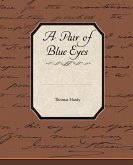A Pair of Blue Eyes is a novel by Thomas Hardy, published in 1873, first serialised between September 1872 and July 1873. It was Hardy's third published novel, and the first not published anonymously upon its first publication. Hardy included it with his "romances and fantasies". A Pair of Blue Eyes normally is categorised as one of Hardy's minor works, "a book with a few good points but a failure as a whole". Like Desperate Remedies, it contains melodramatic scenes that appear disconnected from the characters and plot. A focus of critical interest of the novel is the scene in which Henry Knight reviews the entire history of the world as he hangs over the edge of a cliff (reputedly the origin of the term "cliffhanger"), and eventually is rescued by a rope of Elfride's underwear. Carl J. Weber sources the scene to a picnic Hardy and his wife had, in which he was sent to search for a lost earring, claiming this passage is the "first indication in the novels of Hardy's ability to sustain interest in a tense situation by sheer power of vivid description." On the other hand, Millgate claims the scene forms part of the "irrelevant" description suited to the "rag-bag" of a novel. For Jean Brooks, the scene is "macabre" and an illustration of "cosmic indifference", also highlighting the comic in the rescue. However, Gittings and Halperin claim it is more likely the idea for this scene comes from an essay by Leslie Stephen titled "Five minutes in the Alps". The "cliff without a name", as it is referred to, is probably based on Beeny Cliff. (wikipedia.org)








